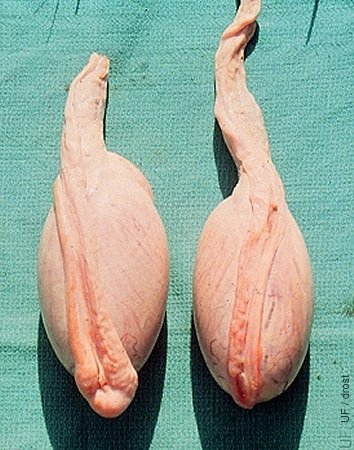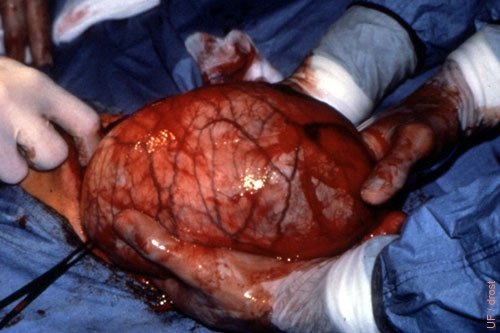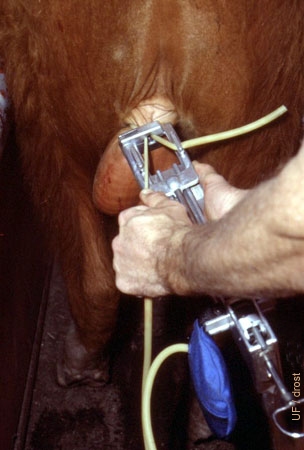The Visual Guide to
Bovine Reproduction
- Bulls
- Testis and Epididymis
- Accessory Sex Glands
- Scrotum
- Penis
- Prepuce
- Semen
- Breeding Soundness Evaluation
- Breeding Capacity
- Vasectomy
Male Reproductive System: Testis and Epididymis
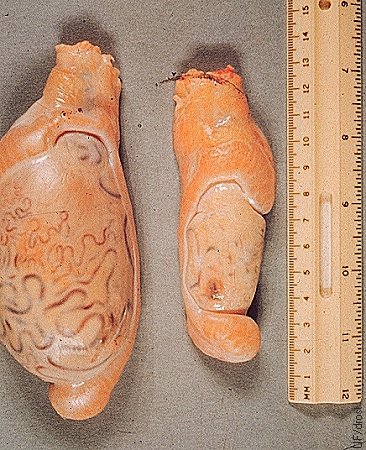
Testicular Atrophy.
Atrophy of the right testicle is the result of taking a testicular biopsy specimen. During the procedure, hemorrhage was controlled by compressing the blood supply to the testis, which led to infarction. Notice the small scar at the ventral aspect of the testis.
Roberts SJ (1973)
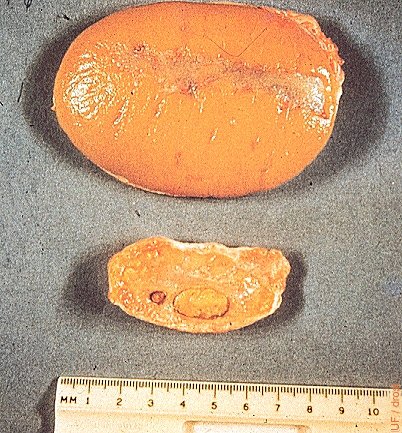
Atrophy After Biopsy.
Cross section of the testicle after a biopsy attempt. The contralateral testis is normal
Roberts SJ (1973)
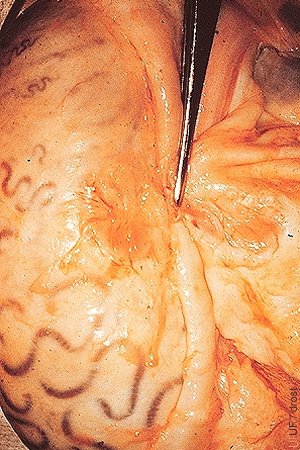
Testicular Biopsy Attempt.
In the process of obtaining a biopsy specimen, the biopsy instrument was blindly inserted into the body of the epididymis. The pointer indicates the scar as well as adhesions and necrosis.
Roberts SJ (1973)

Testicular Hemorrhage.
Testicular hemorrhage following a biopsy procedure. A blind needle biopsy procedure is not recommended in the bull due to the abundance of blood vessels, particularly in the caudal region of the testis.
Roberts SJ (1973)
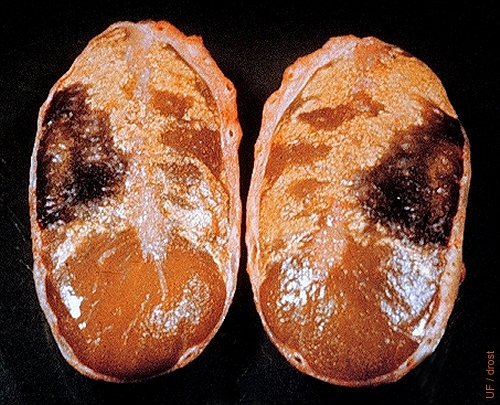
Testicular Infarct.
Testicular infarct due to the biopsy procedure.
Roberts SJ (1973)
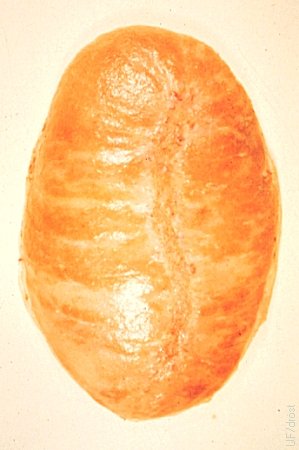
Testicular Degeneration.
Testicular degeneration, fibrosis and calcified tubules.
Roberts SJ (1973)
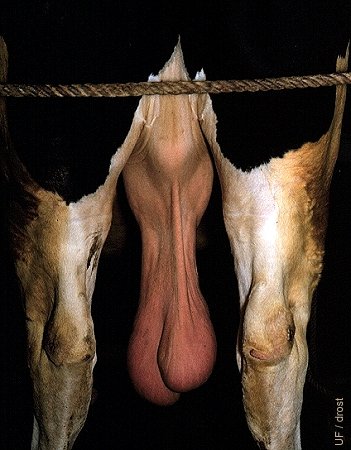
Testicular Atrophy.
Small, soft, asymmetrical testes. Long pendulous scrotum. The bulge dorsal to the neck of the scrotum represents the distal sigmoid flexure the penis.
Roberts SJ (1973)
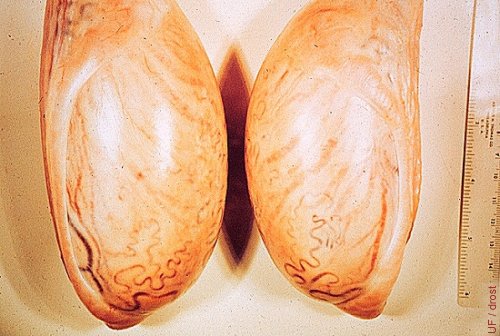
Segmental Aplasia.
Bilateral segmental aplasia of the mesonephric ducts (Wolffian ducts). Notice the virtual absence of the caput and cauda epididymidis.
Roberts SJ (1973)
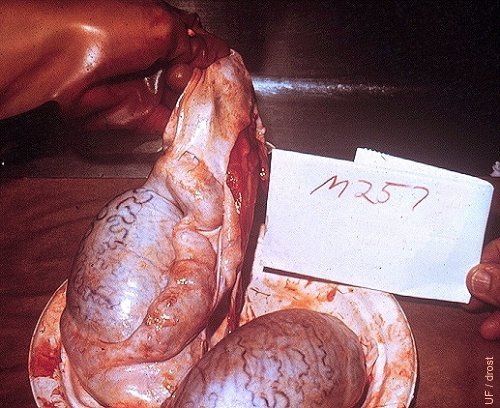
Epididymitis (Brucellosis).
The body of the epididymis is greatly enlarged due to infection with Brucella abortus.
Nicoletti PL (1980)
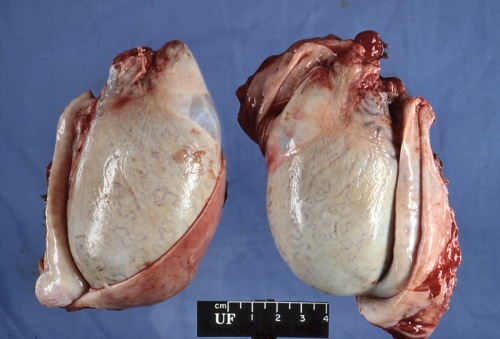
Bison Testes.
Normal American bison [Bison bison] testicles. Reciprocal crosses with Bos taurus have occurred, but best results are obtained when domestic bulls are used on bison cows. Matings between bison bulls and domestic cows result in problems, including hydrallantois.
Nicoletti PL (1980)
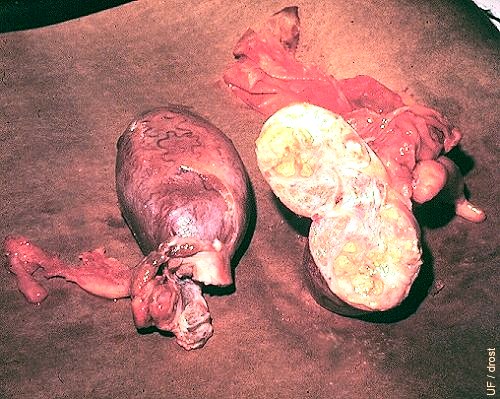
Brucella Infection of the Testis.
Abscessation and infection of the testis due to Brucella abortus.
Nicoletti PL (1980)
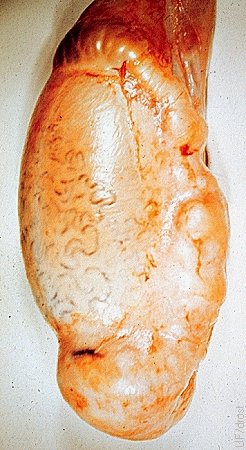
Epididymitis.
Inflammation of the body and tail of the epididymis. This bull had traumatic gastritis and vegetative endocarditis due to Arcanobacterium pyogenes which extended to the seminal vesicular glands and the epididymides.
Roberts SJ (1973)
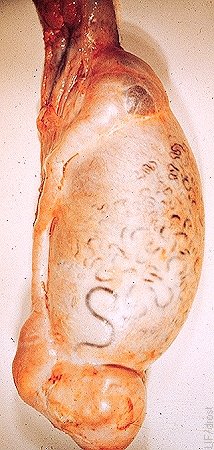
Caudal Epididymitis.
Inflammation of the cauda epididymidis only. Contralateral testis of the previous image.
Roberts SJ (1973)
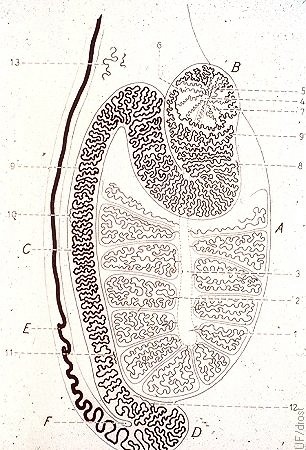
Epididymal Duct System.
Diagram of the entire epididymal duct system ending in the vas deferens.
Larsen RE (1982)
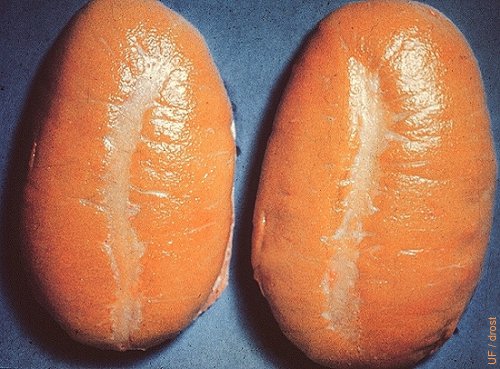
Testicular Pressure.
The cut surface of this normal testis bulges, reflecting normal intratesticular pressure. Normal 7.5-year old Jersey bull.
Drost M (1980)
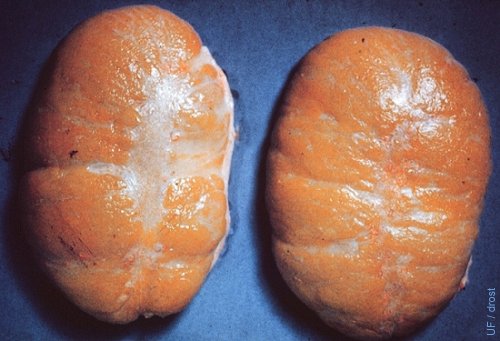
Testicular Fibrosis.
Bilateral testicular fibrosis. While these testicles felt firm on palpation, they lacked the normal resilience.
Roberts SJ (1973)
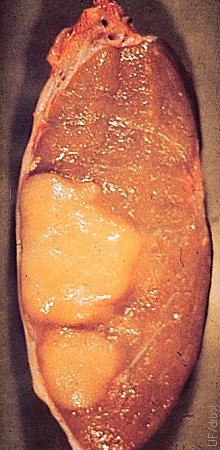
Sertoli Cell Tumor.
Sertoli cell tumor. Sustentacular cell tumor.
Roberts SJ (1973)
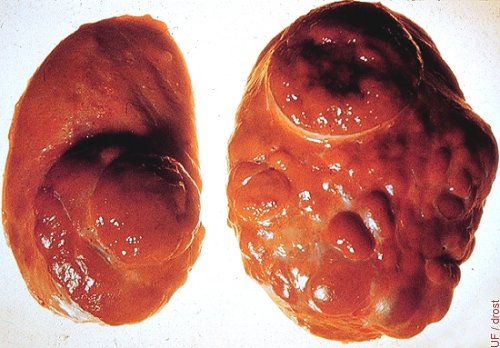
Interstitial Cell Tumor.
Bilateral interstitial cell tumors. Ten year old sterile Guernsey bull.
McEntee K (1973)
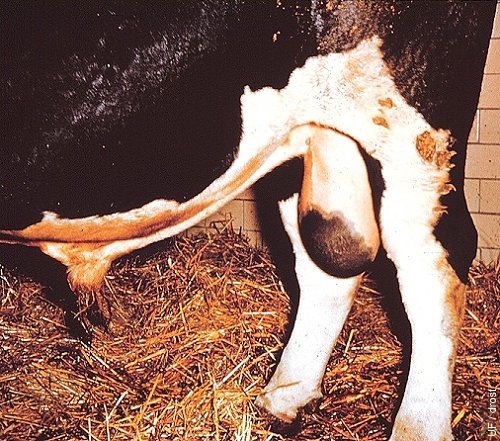
Orchitis.
Orchitis. History unknown. Testis is enlarged and feels firmer than normal, and may be sensitive to palpation.
Roberts SJ (1973)
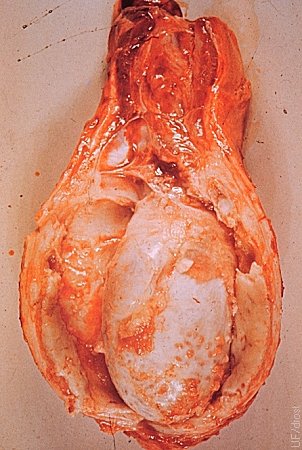
Peri-orchitis.
Peri-orchitis due to Arcanobacterium pyogenes infection. This bull was used successfully for 3 years after unilateral castration.
McEntee K (1973)
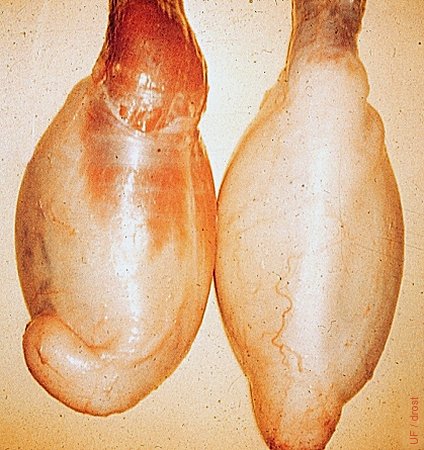
Anomalous Cremaster Muscle.
The cremaster muscle is attached too low to the tunic of the left testicle, resulting in rotation of the testis.
Roberts SJ (1973)
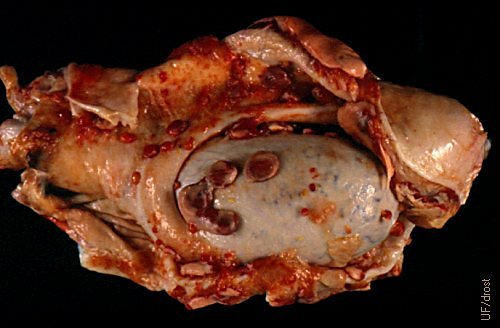
Mesothelioma.
These lesions were identified in a slaughterhouse specimen.
Drost M (1980)
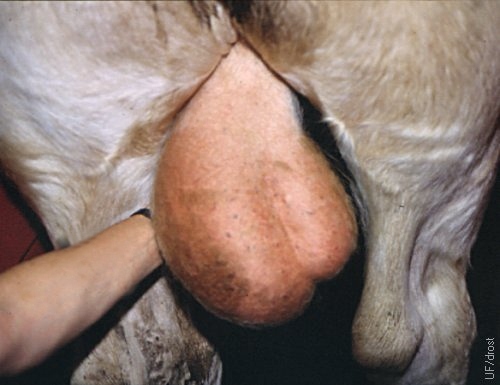
Hydrocele.
Left scrotal enlargement due to hydrocele in a Simmental bull. Diagnosis confirmed with ultrasound.
Larsen RE (1998)

Ultrasonography of the Testis.
Hydrocele. Ultrasonography permits confirmation of the presence of fluid and assessment of its nature.
Larsen RE (1998)
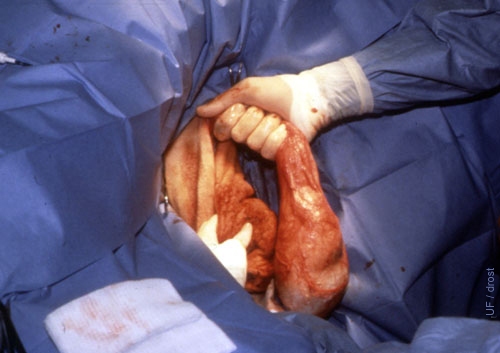
Unilateral Castration.
Unilateral castration of a Simmental bull with a chronic unilateral hydrocele.
Larsen RE (1998)
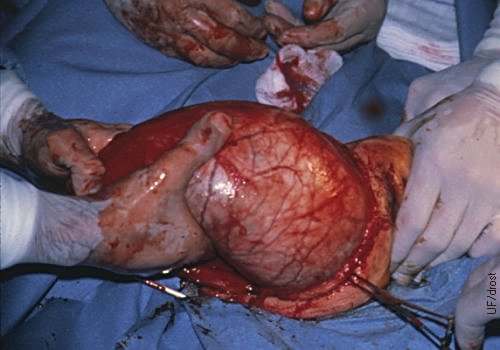
Unilateral Castration.
Unilateral castration under general anesthesia.
Larsen RE (1998)
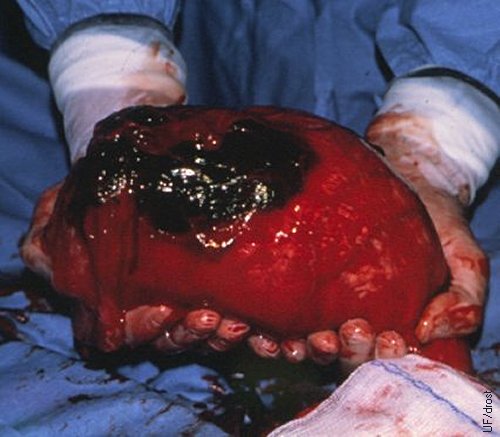
Unilateral Castration.
Hydrocele of traumatic origin. Treated with unilateral castration.
Larsen RE (1998)
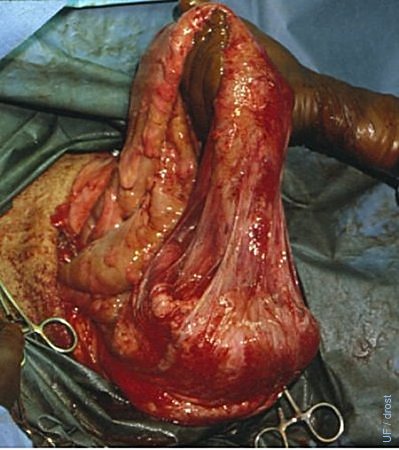
Testicular Adhesions.
Unilateral castration of a testis surrounded by adhesions in a Santa Gertrudis bull that had a unilateral scrotal hernia.
Larsen RE (1980)
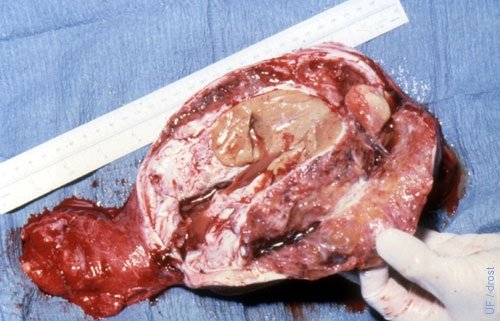
Traumatic Orchitis.
Testis removed by unilateral castration. Diagnosis: traumatic orchitis with adhesions.
Larsen RE (1982)
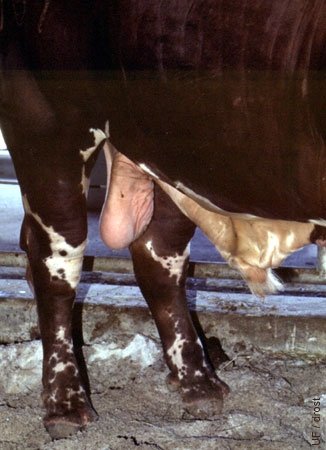
Post-Op Unilateral Castration.
After unilateral castration this bull was returned to service.
Larsen RE (2001)
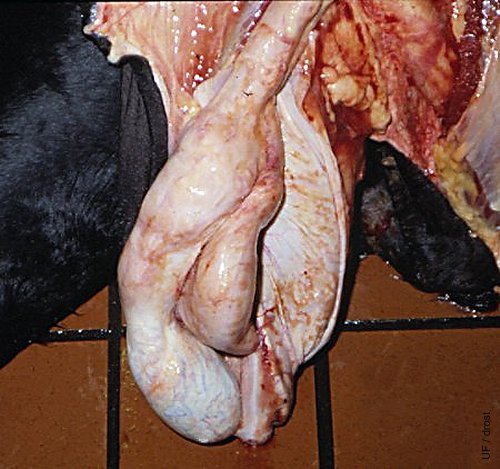
Lymphosarcoma.
Lymphosarcoma of the spermatic cord. [15 cm square tile].
Larsen RE (1985)
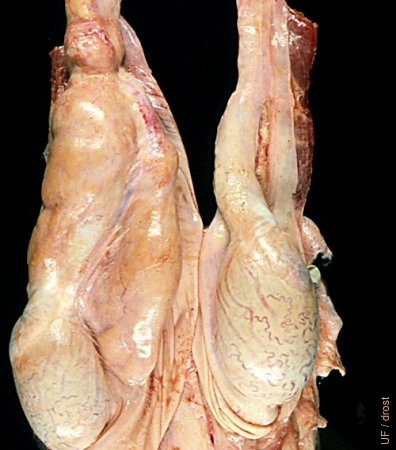
Malignant Lymphoma.
Malignant lymphoma of the spermatic cord of a 3 year old Angus bull. The spermatic cord and the common tunics were enlarged and bulging due to the neoplastic growth.
Larsen RE (1985)
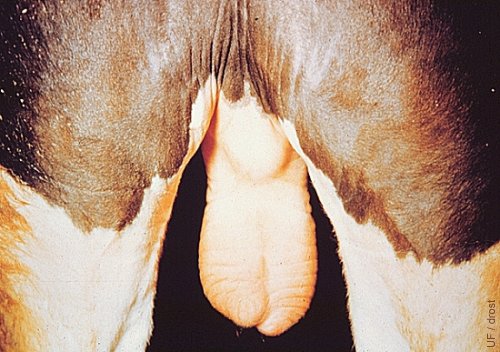
Bilateral Testicular Hypoplasia.
Note the space between the scrotum and the legs. Normally the scrotum fills the entire space.
Roberts SJ (1973)
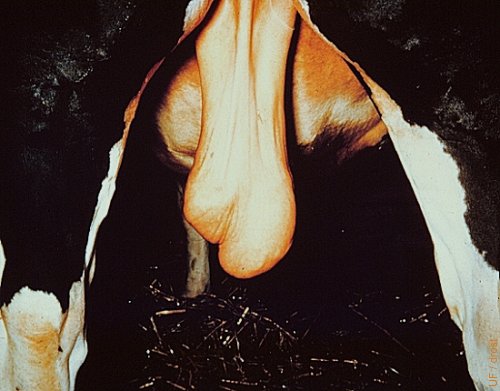
Severe Testicular Degeneration.
Severe bilateral testicular degeneration (atrophy). Soft testes. Small scrotal circumference. Unknown etiology.
Roberts SJ (1973)
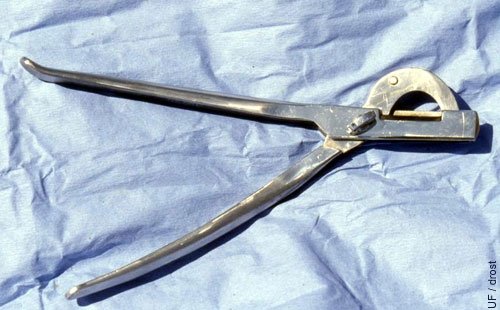
Emasculator.
Emasculator used for castration in stallions, bulls, large boars, rams, and bucks. This instrument crushes and cuts.
Larsen RE (2001)

Emasculation.
Placement of the emasculator, which crushes and cuts, is critical. The crushing bar must be placed on the proximal end of the spermatic cord. The cutting blade must oriented towards the testis. In the vernacular: "the (wing)nut towards the nut (testis)".
Larsen RE (2001)

Elastrator.
The rubber elastrator band (tubing) is tightened via the trigger action of this instrument while holding the band in place around the spermatic cords dorsal to the testes.
Larsen RE (2001)
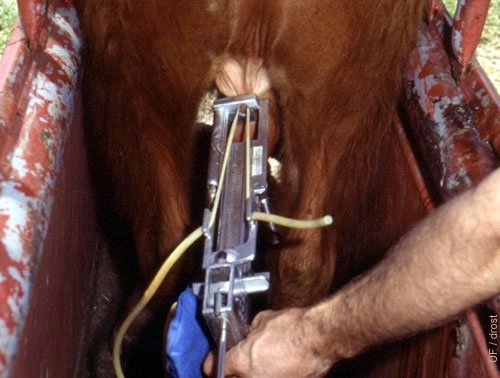
Elastration.
Tightening of the elastrator band, by pulling the trigger on the emasculator.
Larsen RE (1985)
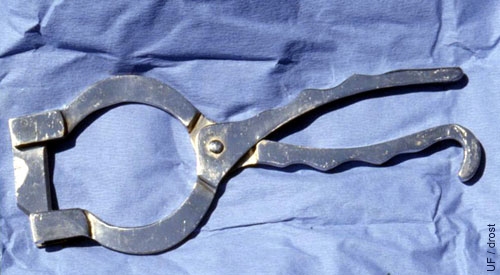
Newberry Knife.
Specially designed scissor-grip castrating knife.
Larsen RE (2000)
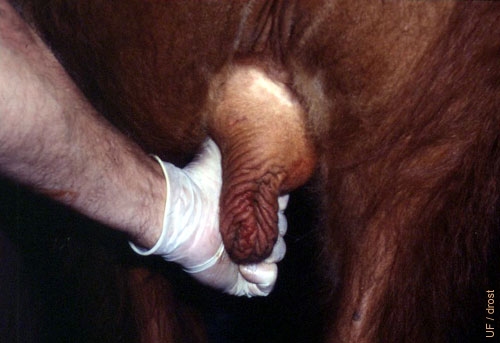
Upward Displacement of the Testes.
Prior to placing the Newberry knife, the testes are pushed up towards the base of the scrotum, to avoid puncturing the testes per se.
Larsen RE (2000)
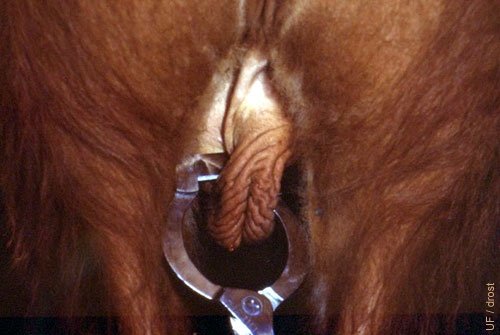
Placement of the Newberry Knife.
When the Newberry knife is placed and closed the horizontal blade pierces the scrotum from side to side.
Larsen RE (2000)
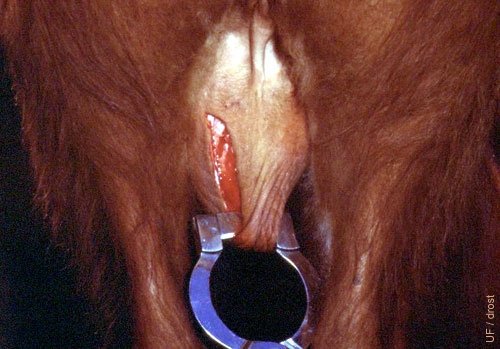
Slitting the Scrotum.
After closure of the Newberry knife the scrotum is slit longitudinally by pulling it towards, and through the bottom of the scrotum.
Larsen RE (2000)
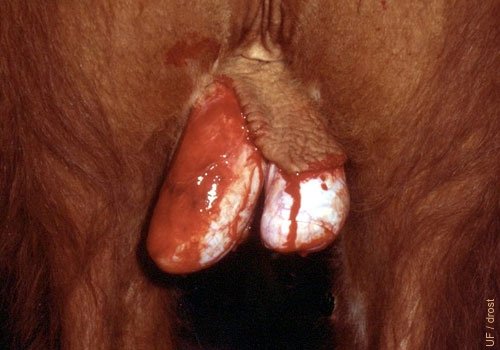
Testes Dropping Down.
After the scrotum has been slit longitudinally, the testes drop down through the liberal incision.
Larsen RE (2000)

